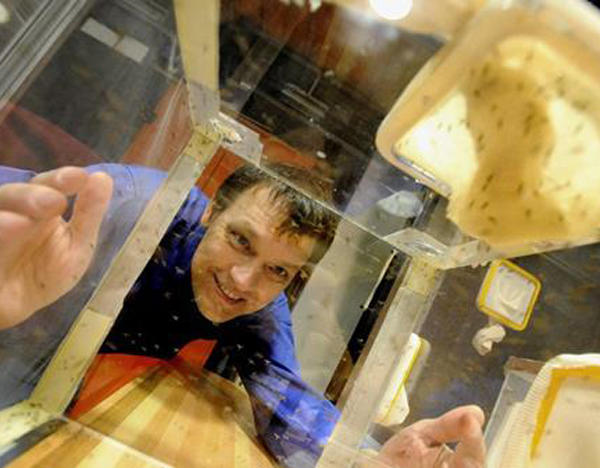Mosquitoes may be the world’s most dangerous pests: They require only stagnant water to breed, evolve quickly to resist insecticides, and spread malaria to 250 million people annually. Each day, nearly 2000 children in sub-Saharan Africa die because of mosquito bites.
Szabolcs Marka, an associate professor of physics, is developing a novel way to protect people from the vectors: a virtual mosquito net with infrared light vibrating at wavelengths that irritate the insects’ nervous systems. He has already proven the concept: In a test chamber in his Pupin Hall laboratory, he has shown that mosquitoes will not transgress an infrared shield.
“Mosquitoes are extremely sensitive to heat and light,” says Marka. “This is partly how they locate their prey — by sensing the infrared light emanating off our bodies. We’ve found that it’s fairly easy to overload and confuse these sensory systems. When they hit the lasers, they stop and turn around.”
Marka’s primary research interest is searching the universe for black holes. An experimental physicist, he develops laser sensors that detect gravitational waves from outer space. A few years ago, while reading about efforts to control malaria-spreading mosquitoes, Marka realized that his work might be useful.
“The malaria problem was already very personal to me,” says Marka, who saw a dorm mate at Kossuth Lajos University, in his native Hungary, die of malaria after visiting Uganda in the early 1990s. “And I’ve always wanted to find a humanitarian application for my work.”
This past fall, Marka received a $1 million grant from the Bill and Melinda Gates Foundation to develop his optical barrier for mosquitoes. His grant was one of five awarded through the foundation’s Grand Challenges Explorations program, which supports experimental projects aimed at improving public health in developing countries. Three other grants went to scientists working on new ways to treat malaria or prevent its transmission.
Said Bill Gates recently: “Some, perhaps many, of these ideas may not pan out. But if even one of these projects is successful, it will have been well worth the investment.”
Marka and his collaborators, who include his wife Zsuzsanna Marka and Imre Bartos, both of whom are also Columbia physicists, are now fine-tuning their technology to find optimal properties of light for repelling mosquitoes.
An even more formidable challenge might be figuring out how to implement the technology. Marka envisions that an infrared barrier could be projected in the shape of a cone over a bed or in the shape of flat curtains in windows and doorways. The light would emanate from simple diode lasers, similar to those found in compact-disc and DVD players.
But how could a rural village without electricity power a laser system? Marka says the lasers use so little electricity that cheap solar panels could accumulate enough energy during the day to power them all night. To test this theory, he and his research team will visit several villages in Tanzania this summer. By inspecting people’s homes and observing the layouts of their villages, the scientists will create computer models to test the efficacy of various implementation strategies.
“We see this as a complementary approach to conventional mosquito nets and insecticides,” says Marka. “And I don’t see any reason why we couldn’t cover everybody’s bed with an infrared shield one day.”



